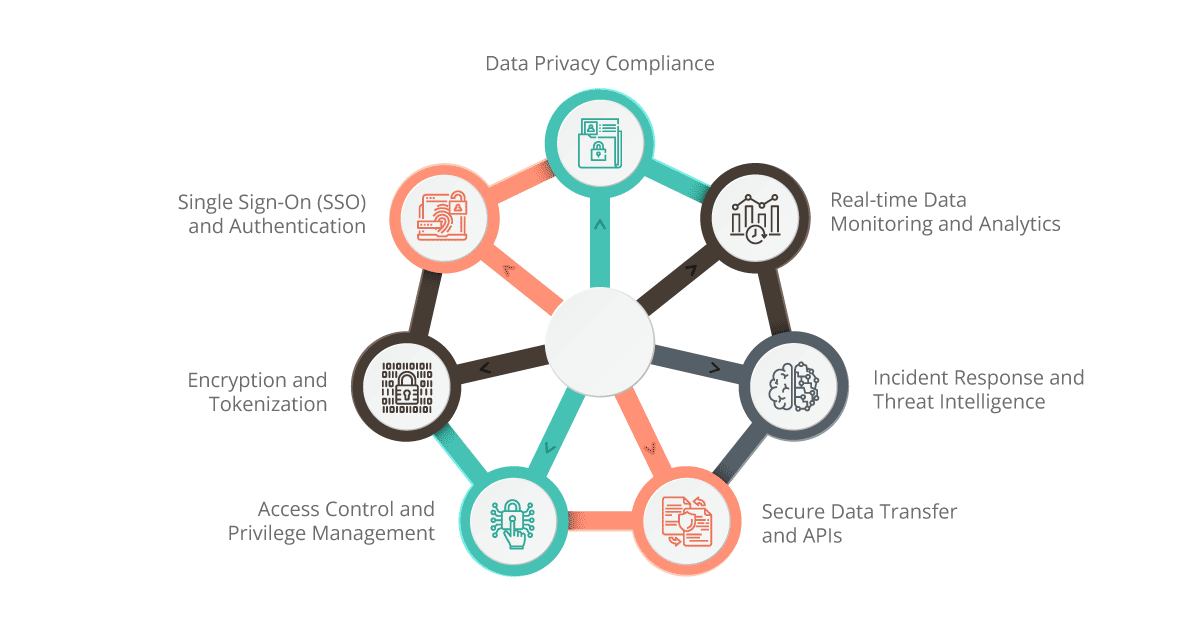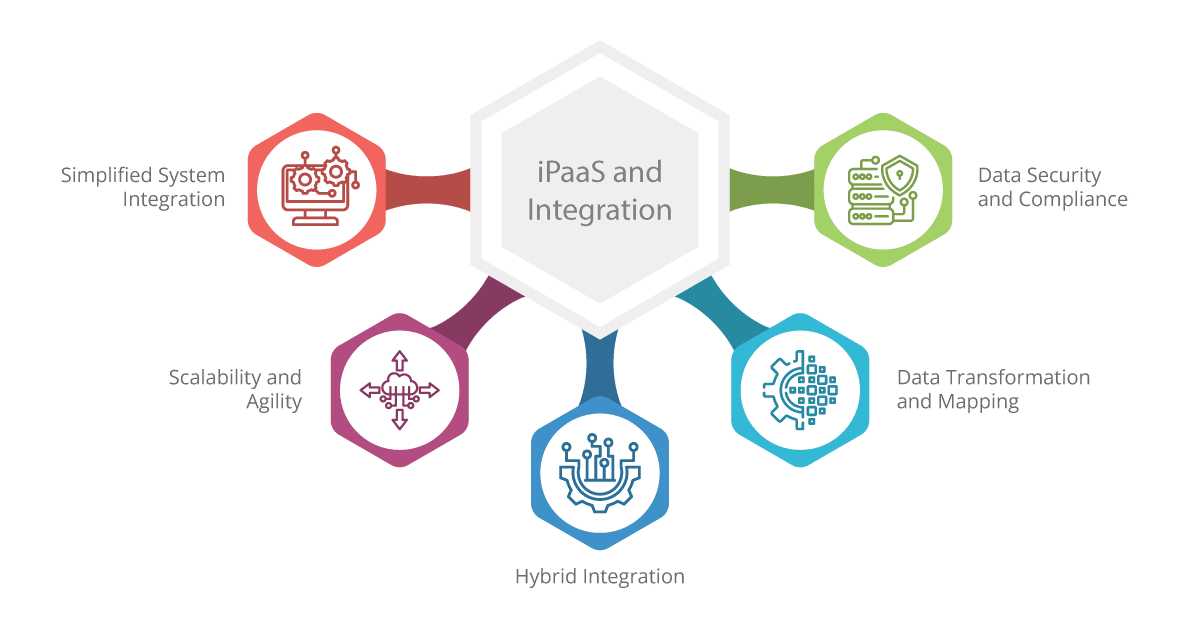Amidst the swirling winds of the digital age, financial services institutions find themselves grappling with an ever-intensifying storm of data security challenges and regulatory compliance demands. In this era of constant cyber threats and evolving regulations, they stand as bastions of trust and guardians of sensitive information. But fear not, for in this turbulent landscape, a powerful force emerges – the seamless integration of systems and applications. Like a beacon of light cutting through the darkness, integration offers a resolute path to confront these formidable obstacles head-on. It bestows financial institutions the ability to exchange data effortlessly, streamline operations with unparalleled efficiency, and fortify their security measures.
In this article, we’ll uncover the pivotal role integration plays in the realm of financial services. Brace yourself for an exploration of its transformative capabilities – the bedrock upon which data security is strengthened and compliance is woven into the very fabric of operations. Prepare to witness the convergence of technology and financial acumen, as integration emerges as the linchpin for a future where data is secure, compliance is unwavering, and financial institutions thrive amidst the tempestuous seas of the industry.
Aonflow iPaaS – Free for First 3 Months!
Build and run up to 1,500 transactions monthly with no cost. No payment info needed!
Integration: Strengthening Data Security
In an era marked by cyber threats and data breaches, safeguarding sensitive financial information is paramount. Integration plays a vital role in enhancing data security in the following ways:
Real-time Data Monitoring and Analytics:
The integration allows financial institutions to consolidate data from various sources in real time. By implementing advanced analytics tools, they can proactively identify potential security breaches and respond swiftly, minimizing the impact of threats. For example, a bank can integrate its transaction data, customer behavior data, and fraud detection systems to detect suspicious activities and prevent fraudulent transactions promptly. Real-time monitoring enables the identification of anomalies or patterns indicative of fraudulent behavior, enabling timely intervention and protection of customer assets.
Single Sign-On (SSO) and Authentication:
Integration solutions enable the implementation of secure authentication methods such as Single Sign-On (SSO), reducing the risk of unauthorized access to critical systems. By consolidating user credentials and enforcing robust authentication protocols, financial institutions can strengthen their security posture. For instance, a financial services firm can integrate its various applications, allowing users to log in once and access multiple systems securely. This not only enhances convenience but also reduces the risk of weak or compromised passwords.
Encryption and Tokenization:
Integration platforms facilitate the encryption and tokenization of sensitive data, ensuring that it remains secure even if intercepted by malicious actors. Encryption makes data indecipherable to unauthorized parties, while tokenization replaces sensitive data with non-sensitive tokens, further mitigating the risk of data breaches. For example, a credit card processing company can integrate its payment systems with encryption and tokenization services to protect customers’ cardholder data. This integration ensures that sensitive financial information is shielded from unauthorized access and provides an additional layer of security in the event of a data breach.
Access Control and Privilege Management:
The integration enables centralized access control and privilege management, allowing financial institutions to manage user permissions and restrict access to sensitive data and applications. By integrating user directories, identity and access management systems, and governance tools, institutions can enforce granular access policies based on user roles, responsibilities, and the principle of least privilege. This integration ensures that only authorized personnel can access sensitive financial data and reduces the risk of data exposure due to unauthorized or inappropriate access.
Secure Data Transfer and APIs:
Integration platforms provide secure methods for data transfer between systems and applications through encrypted channels. Additionally, integration solutions often offer Application Programming Interfaces (APIs) that allow secure and controlled access to data and services. Financial institutions can leverage APIs to securely share data with trusted third-party providers, such as fintech companies while maintaining strict data protection standards. APIs enable seamless data exchange while maintaining robust security measures, enhancing collaboration and innovation within the financial ecosystem.
Incident Response and Threat Intelligence:
Integration solutions facilitate swift incident response and threat intelligence capabilities. By integrating security incident and event management systems (SIEM) with other security tools and external threat intelligence sources, financial institutions can detect and respond to security incidents promptly. The integration enables the correlation of security events, identification of potential threats, and automated incident response workflows. This proactive approach strengthens the institution’s security posture and reduces the time to identify and mitigate security incidents.
Data Privacy Compliance:
Integration assists financial institutions in achieving and maintaining compliance with data privacy regulations, such as the General Data Protection Regulation (GDPR) or the California Consumer Privacy Act (CCPA). By integrating data privacy management platforms, consent management systems, and data classification tools, institutions can implement data protection measures, track data usage, and ensure adherence to regulatory requirements. Integration streamlines privacy compliance efforts, simplifies data governance, and reduces the risk of fines or reputational damage due to non-compliance.
Compliance in Financial Services: Navigating Regulatory Challenges
The financial industry is heavily regulated, with stringent requirements imposed by regulatory bodies such as the Securities and Exchange Commission (SEC), the Financial Conduct Authority (FCA), and the Consumer Financial Protection Bureau (CFPB). Integration plays a critical role in helping financial institutions navigate these regulatory challenges:
Automated Regulatory Reporting:
Integration platforms enable automated regulatory reporting by consolidating data from various systems and generating accurate and timely reports. By integrating with reporting tools and regulatory compliance systems, financial institutions can streamline the process of gathering and aggregating data required for regulatory submissions. This integration reduces manual effort, minimizes the risk of errors, and ensures compliance with reporting deadlines.
Know Your Customer (KYC) and Anti-Money Laundering (AML) Compliance:
Integration solutions assist financial institutions in implementing robust KYC and AML compliance programs. By integrating customer onboarding systems, identity verification services, and transaction monitoring tools, institutions can streamline due diligence processes and detect suspicious activities effectively. This integration enables efficient KYC checks, continuous monitoring of customer transactions, and the identification of potential money laundering or terrorist financing activities.
Audit Trail and Data Retention:
Integration facilitates the creation of comprehensive audit trails and ensures proper data retention practices. By integrating transactional systems, logging mechanisms, and archival solutions, financial institutions can capture and retain data required for compliance audits. Integration streamlines the retrieval of historical data, simplifies the audit process, and demonstrates adherence to regulatory requirements.
Regulatory Change Management:
Integration solutions assist financial institutions in managing regulatory changes effectively. By integrating regulatory intelligence platforms, compliance management systems, and policy repositories, institutions can stay up to date with evolving regulations, automate compliance updates, and ensure adherence to regulatory requirements. This integration simplifies the compliance process, reduces manual efforts, and minimizes compliance-related risks.
Cross-Border Regulatory Compliance:
Integration plays a crucial role in facilitating cross-border regulatory compliance. Financial institutions operating in multiple jurisdictions can integrate their compliance systems with country-specific regulatory frameworks and reporting requirements. This integration ensures that compliance measures are tailored to each jurisdiction, reduces the risk of non-compliance, and enhances regulatory transparency.
Aonflow is the leading integration platform.
You can kick-start by integrating your first-ever workflow in just a matter of minutes.
iPaaS and Integration: A Perfect Union
Integration Platform as a Service (iPaaS) is a cloud-based integration solution that empowers financial institutions to connect their on-premises systems with cloud-based applications securely. iPaaS offers a range of benefits and use cases that align with the role of integration in financial services:
Simplified System Integration:
iPaaS provides a user-friendly interface and pre-built connectors that simplify the integration of various systems and applications. Financial institutions can leverage iPaaS to connect their core banking systems, customer relationship management (CRM) platforms, and other applications seamlessly. This integration enhances data flow, improves process efficiency, and ensures data consistency across systems.
Scalability and Agility:
iPaaS enables financial institutions to scale their integration capabilities as their business needs evolve. As the volume of data and the complexity of integrations increase, iPaaS allows for the seamless addition of new applications, systems, and data sources. Financial institutions can adapt quickly to changing business requirements, launch new products and services faster, and stay ahead of the competition.
Data Transformation and Mapping:
iPaaS solutions offer powerful data transformation and mapping capabilities, allowing financial institutions to normalize data formats, translate between different data standards, and ensure data consistency across integrated systems. This functionality is particularly useful when integrating with external partners or complying with industry-specific data standards.
Hybrid Integration:
iPaaS supports hybrid integration scenarios, allowing financial institutions to connect both on-premises and cloud-based systems. This flexibility is essential for institutions that have a mix of legacy systems and cloud-based applications. iPaaS enables seamless integration between these disparate systems, enabling data exchange and process automation across the entire infrastructure.
Data Security and Compliance:
iPaaS providers prioritize data security and compliance with industry standards. They employ robust security measures such as encryption, access controls, and monitoring capabilities to protect data during integration processes. iPaaS solutions also offer features to ensure compliance with data protection regulations, such as GDPR, by providing tools for data anonymization, consent management, and data lifecycle management.
Use Cases
Trade Settlements Automation:
Financial institutions can leverage iPaaS to automate trade settlement processes. By integrating trading systems, post-trade processing platforms, and clearinghouse interfaces, they can streamline the matching, confirmation, and settlement of trades. iPaaS enables efficient data exchange, reduces manual effort, and accelerates settlement cycles, leading to faster and more accurate trade settlements.
Cross-Border Payment Integration:
With iPaaS, financial institutions can integrate their payment systems with international payment networks and compliance platforms. This integration simplifies cross-border payments, ensures compliance with anti-money laundering regulations, and enhances the speed and transparency of international fund transfers.
Risk Management Integration:
iPaaS allows financial institutions to integrate risk assessment tools, market data feeds, and portfolio management systems for comprehensive risk management. By consolidating data from various sources, institutions can gain real-time insights into market trends, monitor portfolio performance, and make informed risk-based decisions.
Customer Support Integration:
iPaaS enables the integration of customer support systems, CRM platforms, and communication channels. This integration provides a unified view of customer interactions, enables personalized support, and facilitates timely responses to customer queries or issues. Financial institutions can deliver superior customer experiences, improve customer satisfaction, and build long-term relationships.
Compliance Management Integration:
With iPaaS, financial institutions can integrate regulatory intelligence platforms, compliance management systems, and policy repositories. This integration ensures timely updates on regulatory changes, automates compliance processes, and facilitates the implementation of consistent compliance measures across the organization.
Wealth Management Integration:
Financial institutions can leverage iPaaS to integrate client relationship management (CRM) systems, portfolio management platforms, and financial planning tools. This integration enables centralized client data management, personalized investment strategies, and seamless collaboration between advisors and clients in the wealth management space.
Real-time Fraud Detection Integration:
iPaaS can be utilized to integrate fraud detection systems, transactional data, and artificial intelligence algorithms. This integration empowers financial institutions to detect and respond to fraudulent activities in real time, enhancing their ability to protect customer assets and minimize financial losses.
Regulatory Reporting Automation:
With iPaaS, financial institutions can automate the process of regulatory reporting by integrating reporting tools, data repositories, and compliance systems. This integration reduces manual effort, improves data accuracy, and ensures timely submission of regulatory reports, leading to enhanced regulatory compliance.
Open Banking Integration:
iPaaS enables financial institutions to comply with open banking initiatives by integrating their core systems with third-party APIs. This integration allows for secure and controlled data sharing, fostering collaboration with fintech providers, and delivering innovative services to customers.
Data Governance and Data Privacy Integration:
iPaaS can be utilized to integrate data governance tools, consent management systems, and data classification platforms. This integration ensures compliance with data privacy regulations, such as GDPR, by providing centralized data governance capabilities, tracking data usage, and facilitating data subject consent management.
Fraud Prevention and Detection:
Financial institutions can leverage iPaaS to integrate fraud prevention and detection systems with transactional data and advanced analytics. By consolidating data from multiple sources, such as transaction history, customer behavior patterns, and external fraud databases, institutions can detect fraudulent activities in real-time. The integration enables the correlation of data and the application of sophisticated algorithms to identify suspicious patterns, enabling prompt action to prevent fraud and protect customer assets.
Vendor Management Integration:
iPaaS facilitates the integration of vendor management systems, risk assessment tools, and compliance platforms. Financial institutions can streamline the onboarding and ongoing management of third-party vendors, ensuring compliance with regulatory requirements and mitigating the risks associated with outsourcing. The integration enables the exchange of vendor data, contract management, and monitoring of vendor performance, enhancing transparency and accountability in vendor relationships.
Regulatory Change Management:
Integration platforms can be used to integrate regulatory change management systems, internal policy repositories, and compliance workflows. This integration enables financial institutions to stay abreast of regulatory changes, automate the dissemination of updates to relevant stakeholders, and track the implementation of policy changes. By centralizing regulatory information and streamlining compliance processes, the integration supports effective regulatory change management, ensuring timely adherence to evolving regulatory requirements.
Identity and Access Management (IAM):
iPaaS enables the integration of IAM systems, user directories, and authentication mechanisms. Financial institutions can establish a robust IAM framework by consolidating user identities, enforcing strong authentication protocols, and implementing access controls based on roles and responsibilities. Integration ensures that only authorized personnel have access to sensitive data and systems, reducing the risk of data breaches and maintaining compliance with data protection regulations.
Audit and Compliance Trail:
Financial institutions can leverage iPaaS to integrate audit trail management systems, compliance logging mechanisms, and data retention solutions. This integration enables the capture, storage, and retrieval of audit logs and compliance-related data, ensuring transparency and accountability. By consolidating audit trail information, financial institutions can demonstrate compliance with regulatory requirements, facilitate internal and external audits, and effectively respond to compliance inquiries.
Anti-Financial Crime Integration:
Financial institutions can leverage iPaaS to integrate anti-financial crime solutions such as anti-fraud, anti-money laundering (AML), and counter-terrorism financing (CTF) systems. This integration enables the seamless exchange of data between various systems, facilitating real-time monitoring of transactions, identification of suspicious activities, and timely reporting to regulatory authorities. Integration enhances the institution’s ability to detect and prevent financial crimes, ensuring compliance with regulatory requirements and safeguarding the integrity of the financial system.
Cybersecurity Incident Response:
Integration platforms can be utilized to integrate cybersecurity incident response systems, threat intelligence feeds, and security information and event management (SIEM) solutions. Financial institutions can leverage integration to establish a coordinated and automated incident response process. By integrating these systems, institutions can detect and respond to cybersecurity threats in real-time, reducing the impact of potential breaches, and ensuring compliance with data protection regulations.
Data Loss Prevention (DLP) Integration:
iPaaS enables the integration of DLP solutions with various data repositories, communication channels, and endpoint devices. Financial institutions can leverage integration to enforce data protection policies, monitor data flows, and prevent unauthorized data disclosure. Integration enhances data visibility and control, mitigates the risk of data breaches, and ensures compliance with data privacy regulations.
Internal Controls and Governance:
Integration platforms can be used to integrate internal controls and governance systems, risk management frameworks, and compliance management platforms. This integration enables financial institutions to establish and enforce robust internal control mechanisms, monitor risk exposure, and ensure compliance with regulatory requirements and internal policies. Integration streamlines control assessments, facilitates risk reporting, and enhances governance practices, contributing to a strong compliance culture within the organization.
Regulatory Sandbox Integration:
With iPaaS, financial institutions can integrate regulatory sandbox environments, test data repositories, and development platforms. This integration allows institutions to create a controlled testing environment for new products, services, or technologies while ensuring compliance with regulatory guidelines. The integration enables the secure exchange of test data, monitoring of activities, and reporting of outcomes, supporting innovation while maintaining regulatory oversight.
Final Thoughts
The role of integration in financial services is multi-faceted. It not only strengthens data security measures but also enables financial institutions to navigate the complex landscape of regulatory compliance. Through the power of integration, financial institutions can fortify their data security, streamline operations, enhance customer experiences, and ensure compliance with regulatory requirements. With the advent of iPaaS, integration has become even more accessible, offering scalable, secure, and agile solutions. By embracing integration and leveraging iPaaS capabilities, financial institutions can unleash the full potential of their data assets, drive innovation, and thrive in an ever-evolving industry.
Aonflow iPaaS – Free for First 3 Months!
Build and run up to 1,500 transactions monthly with no cost. No payment info needed!


